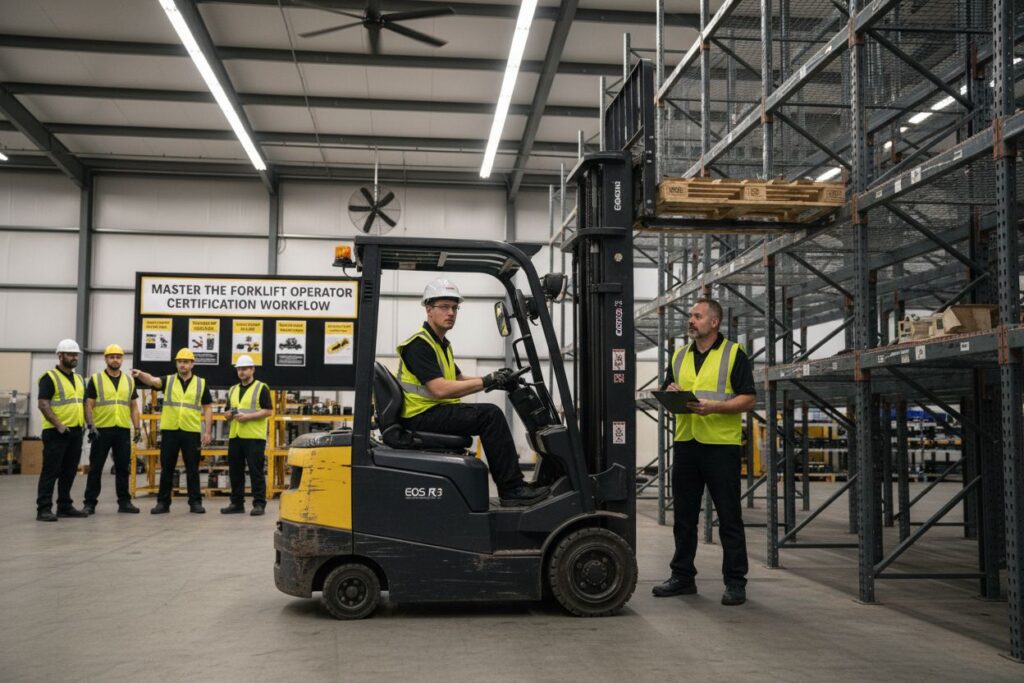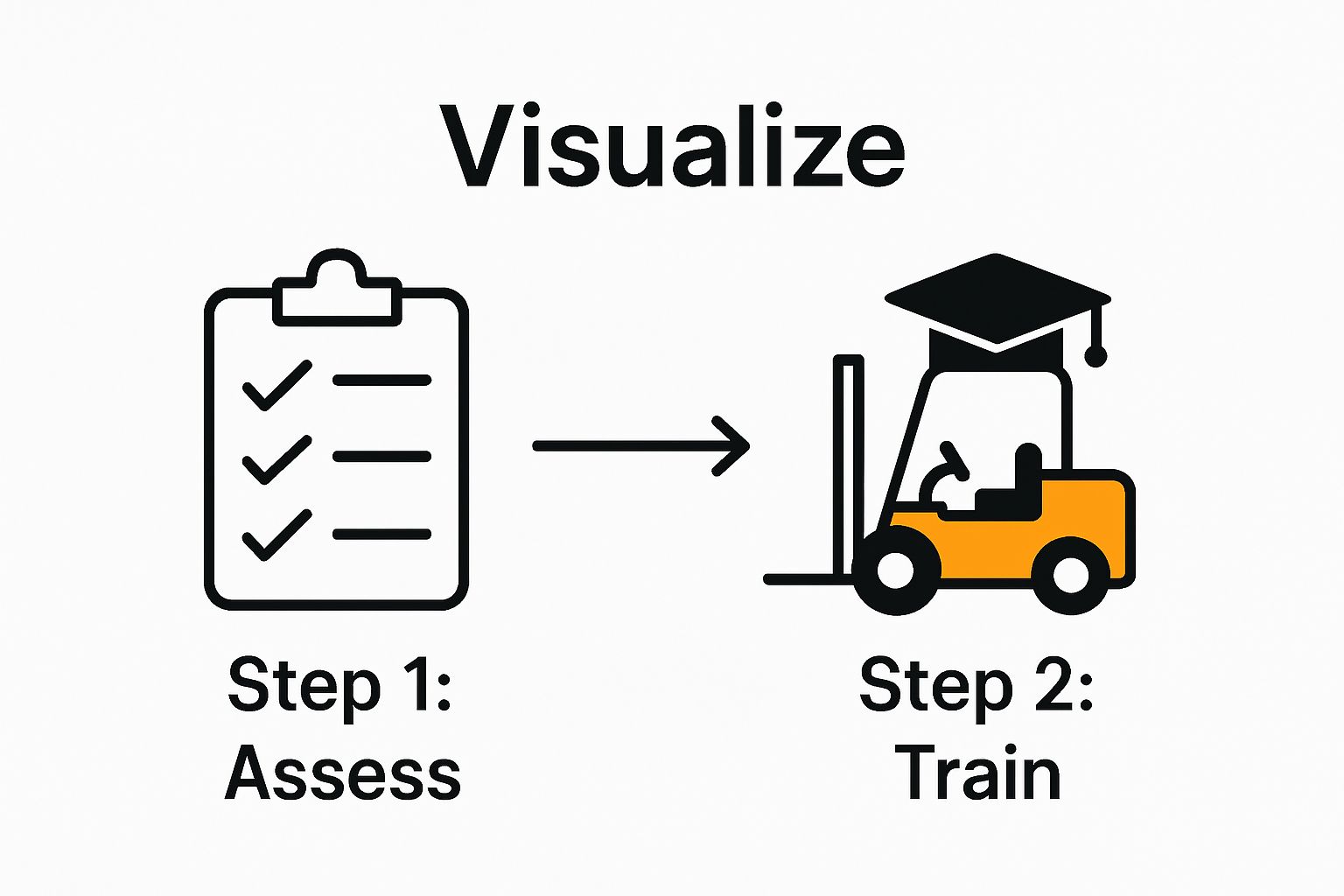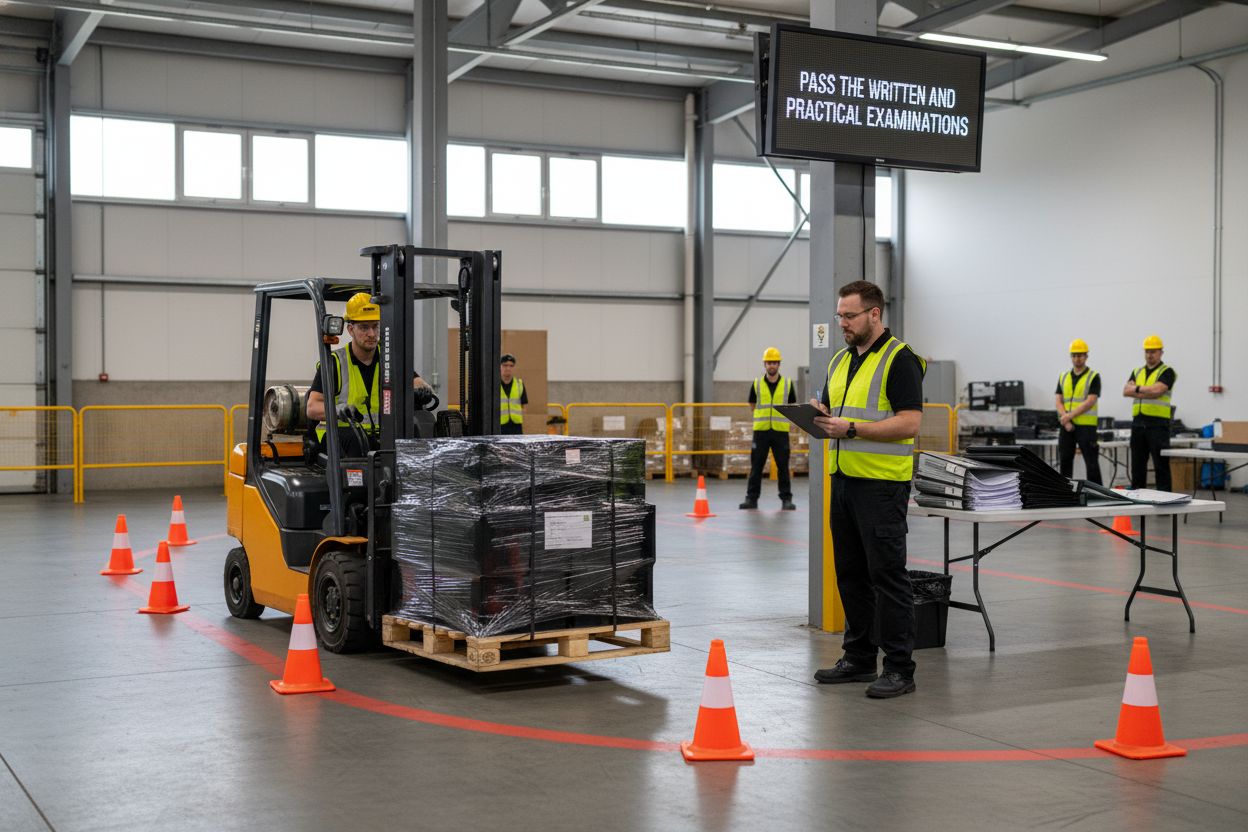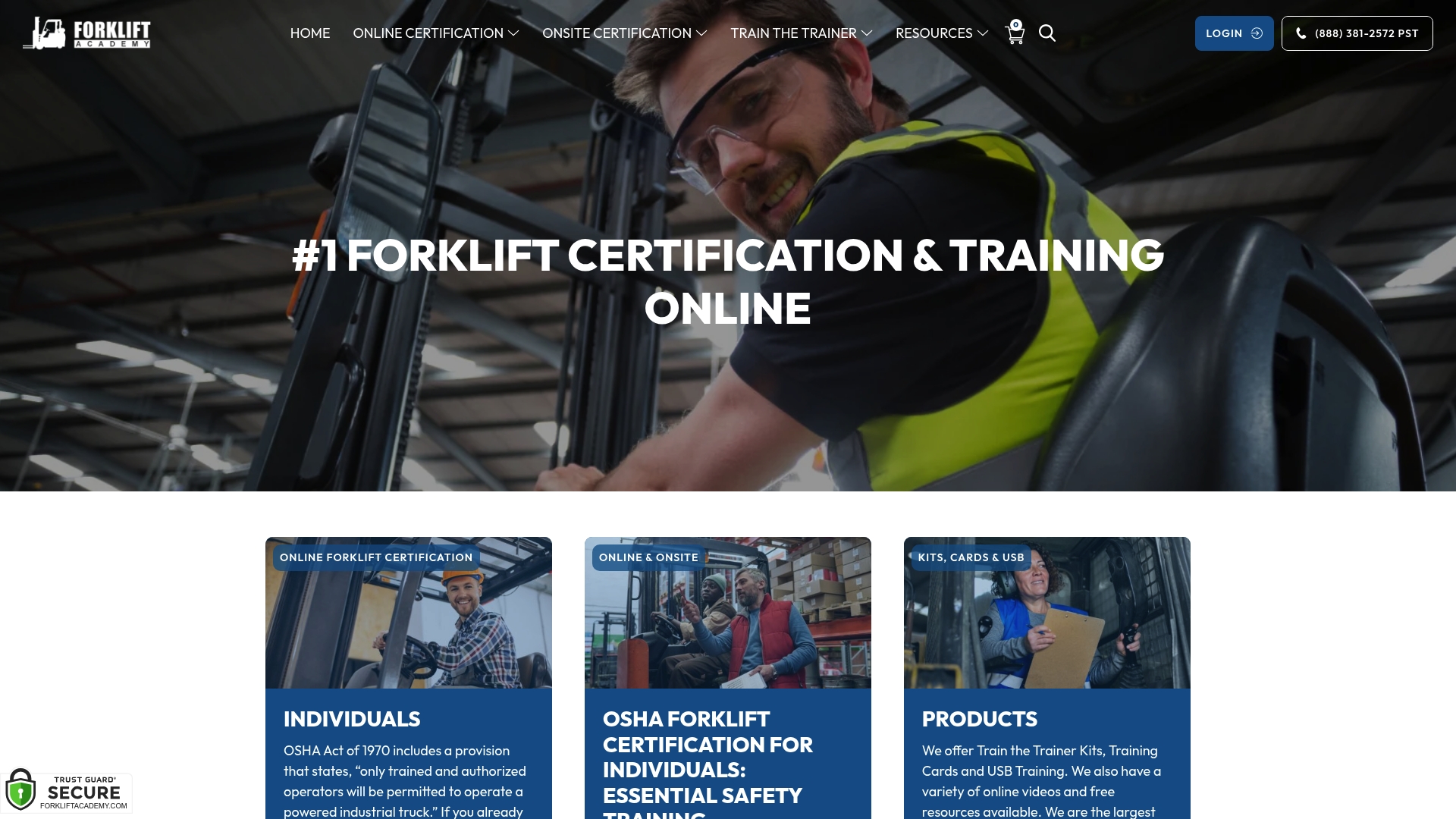
Forklift operator jobs are in high demand across logistics, warehousing, and manufacturing. The surprising part is that OSHA reports every forklift operator must complete a certified training program and recertify every three years. Most people think driving a forklift is all about raw strength or basic driving skills but the reality is your safety knowledge and ongoing training play a bigger role in landing and keeping these jobs.
| Key Point | Explanation |
|---|---|
| 1. Assess your current skills | Evaluate your knowledge and experience to identify training needs for forklift certification. |
| 2. Choose an accredited training program | Select a program that meets OSHA standards and includes both theory and practical experience. |
| 3. Complete training modules effectively | Engage in both classroom learning and hands-on practice to master operational skills and safety protocols. |
| 4. Pass written and practical exams | Demonstrate your understanding of safety and operational techniques to earn your forklift operator certification. |
| 5. Stay updated and renew certification | Maintain your certification through ongoing education and comply with OSHA regulations every three years. |
Beginning your forklift operator certification journey requires a strategic self-assessment of your current skills, experience, and readiness. This initial step is critical for understanding your starting point and identifying the specific training pathways that will transform you into a professional, OSHA-compliant forklift operator.

Your assessment process starts with an honest evaluation of your existing knowledge and practical experience with industrial equipment. If you have prior warehouse, logistics, or material handling experience, you likely have foundational skills that will accelerate your certification. However, even without direct forklift experience, your mechanical aptitude, safety awareness, and physical coordination are valuable assets.
According to OSHA standard guidelines, employers must comprehensively evaluate an employee’s competence in operating powered industrial trucks. This means your self-assessment should mirror professional evaluation criteria. Consider your abilities in several key areas:
Realistic self-evaluation helps you understand whether you need comprehensive training or can pursue a more streamlined certification process. Some individuals might require full beginner training, while others with relevant experience might qualify for expedited evaluation programs.
Professional tip: Document your current skills and work history. Create a detailed personal inventory that highlights transferable skills from previous jobs, such as precision work, equipment handling, or safety-conscious roles. This documentation will be valuable during your certification process and can potentially demonstrate your readiness to future employers.
The goal of this initial assessment is not to discourage you but to provide a clear roadmap for your certification journey. By understanding your current capabilities and potential areas for improvement, you’ll approach forklift operator training with confidence and strategic focus. Your commitment to thorough self-evaluation sets the foundation for becoming a skilled, safety-conscious professional in material handling and logistics.
Selecting the right certified training program is a critical milestone in your forklift operator certification workflow. This step transforms your potential into professional competence, ensuring you receive comprehensive instruction that meets OSHA compliance standards and prepares you for real-world industrial environments.
Your program selection process should focus on comprehensive curriculum that covers both theoretical knowledge and practical skills. Look for training providers that offer robust programs integrating classroom instruction, interactive learning modules, and hands-on equipment practice. Learn more about our training approaches to understand the depth of quality certification programs.
Professional training programs typically include several key components that you should evaluate during your selection. Prioritize programs that offer detailed safety protocols, equipment operation techniques, load management strategies, and workplace hazard recognition. The ideal certification pathway will not just teach you how to operate a forklift but will transform you into a safety-conscious professional who understands the nuanced responsibilities of material handling.
Consider multiple program delivery formats to match your learning style and schedule. Online programs provide flexibility for working professionals, while in-person training offers direct equipment interaction. Some advanced programs offer hybrid models combining digital learning with practical workshops, giving you comprehensive exposure to forklift operation principles.
Below is a comparison table of different types of forklift training delivery formats mentioned in the article, helping you choose the best fit for your learning needs.
| Training Format | Flexibility | Equipment Interaction | Best For |
|---|---|---|---|
| Online | High | Limited | Working professionals |
| In-person | Moderate | Extensive | Hands-on learners |
| Hybrid (Online + In-person) | Moderate-High | Moderate-Extensive | Those seeking both flexibility and hands-on practice |
Verify the credibility of your chosen training program by checking several critical factors:
Budget considerations are important, but should not compromise training quality. While costs vary, investing in a reputable program ensures you receive thorough preparation for professional certification. Many employers value candidates with high-quality training backgrounds, making your initial investment in education a strategic career decision.
By the end of this selection process, you should have identified a training program that aligns with your learning preferences, career goals, and professional development objectives. Your chosen certification pathway will be your gateway to becoming a skilled, safety-focused forklift operator ready to excel in dynamic industrial environments.
Completing the required training modules is the pivotal stage where theoretical knowledge transforms into practical skill mastery. This comprehensive phase represents your dedicated commitment to becoming a professional, safety-conscious forklift operator who understands both technical operations and critical workplace protocols.
According to OSHA training guidelines, your training will encompass both classroom instruction and hands-on equipment interaction. The classroom segments will cover essential theoretical components including equipment mechanics, safety regulations, load management principles, and workplace hazard identification. These academic modules build the foundational understanding necessary for responsible equipment operation.
Practical training represents the most critical component of your certification journey. During equipment interaction modules, you will learn precise operational techniques, equipment inspection protocols, and real-world maneuvering skills. Instructors will guide you through complex scenarios simulating actual warehouse and industrial environments, ensuring you develop muscle memory and situational awareness. Explore advanced training techniques to understand the depth of professional preparation.
Expect your training to include comprehensive skill assessments that evaluate both your theoretical knowledge and practical competence. These evaluations are designed to challenge your understanding and ensure you can apply learned principles in dynamic workplace scenarios. Instructors will observe your equipment handling, safety consciousness, and ability to make rapid, responsible decisions under various operational conditions.
Key training modules typically cover:
Mental preparation is equally important as technical skill development. Approach each training module with focus, humility, and a genuine desire to learn. Ask questions, request additional demonstrations if needed, and engage actively with your instructors. Your proactive attitude will significantly enhance your learning experience and professional readiness.
By the conclusion of your training modules, you should demonstrate confident equipment handling, comprehensive safety knowledge, and the ability to operate forklifts efficiently and responsibly across diverse industrial settings. This step represents your transformation from a novice learner to a skilled, certified professional ready to contribute meaningfully in material handling environments.
The examination phase represents the critical moment where your training and preparation are put to the ultimate test. Passing both written and practical assessments is your gateway to professional forklift operator certification, demonstrating your comprehensive understanding of safety protocols and operational excellence.
According to OSHA regulations, your certification requires rigorous evaluation through two distinct but interconnected examination components. The written examination will assess your theoretical knowledge, testing your understanding of safety regulations, equipment mechanics, workplace hazard identification, and operational best practices.
The written test typically consists of multiple-choice questions designed to probe your comprehension of critical forklift operation principles. Expect questions that challenge your understanding of load management, equipment maintenance, workplace safety standards, and emergency response protocols. Successful candidates approach this examination with methodical preparation, reviewing training materials thoroughly and understanding the underlying principles behind each safety guideline.
The practical examination represents the most intense and revealing component of your certification process. Here, you will demonstrate your actual operational skills under professional observation. Examiners will evaluate your ability to maneuver the forklift precisely, handle various load configurations, navigate complex warehouse environments, and consistently prioritize safety.
Key examination performance criteria include:
Mental preparation is as crucial as technical skill during these assessments. Approach the examinations with confidence, but not overconfidence. Take deep breaths, remain calm, and focus on demonstrating the skills and knowledge you have diligently developed throughout your training. Remember that examiners are looking for competent, safety-conscious operators who can make responsible decisions under various operational conditions.
Successful completion of both written and practical examinations signifies more than just a certification. It represents your transformation into a professional who understands the critical responsibility of operating powerful industrial equipment safely and efficiently. Your newly earned credentials will open doors to exciting career opportunities in warehousing, logistics, manufacturing, and material handling industries.

Obtaining your forklift operator certification represents the culmination of your dedicated training and professional development journey. This crucial step transforms your hard-earned skills into an official, recognized professional credential that validates your expertise in industrial equipment operation.
Learn more about certification requirements to understand the nuanced process of finalizing your professional qualification. The certification process involves carefully documenting and submitting your training records, examination results, and completing any additional administrative requirements specified by your training provider and local regulatory bodies.
Your certification documentation will typically include several critical components. You will receive an official certification card or document that demonstrates your successful completion of both written and practical examinations. This credential is not just a piece of paper but a professional testament to your commitment to workplace safety and operational excellence. Ensure you carefully review all details on your certification document, verifying that your name, certification date, and specific equipment classifications are accurately represented.
The following checklist table summarizes key verification steps to ensure your forklift operator certification is properly documented and maintained, as described in the certification section.
| Verification Step | Purpose | Completion Indicator |
|---|---|---|
| Receive official certification | Proof of training and assessment completion | Certification card/document |
| Confirm accuracy of personal details | Prevent administrative issues | Correct name and details |
| Review certification validity period | Know when renewal is required | Expiration date present |
| Store certification securely | Ensure easy access when needed | Safe physical/digital copies |
| Prepare for future recertification | Stay compliant with OSHA and employer policies | Set reminders/tracking system |
Many employers and industries require periodic recertification to ensure ongoing skill maintenance and awareness of evolving safety standards. Most forklift operator certifications remain valid for three years, after which you will need to complete a renewal process. This renewal typically involves a refresher course and updated practical assessment to confirm your continued competence and familiarity with current safety protocols.
Key certification verification steps include:
Professional tip: Create digital and physical copies of your certification. Many employers will require you to present your original certification during hiring processes or periodic workplace safety audits. Having multiple backup copies ensures you can quickly demonstrate your professional qualifications.
Your newly obtained forklift operator certification is more than a professional milestone. It represents your commitment to safety, continuous learning, and professional growth. This credential opens doors to exciting career opportunities in warehousing, logistics, manufacturing, and material handling industries, positioning you as a skilled and responsible industrial equipment operator.
Staying current with OSHA regulations and maintaining your forklift operator certification is an ongoing professional commitment that ensures your continued employability and workplace safety expertise. This critical step transforms your initial certification from a one-time achievement into a dynamic, evolving professional credential.
Discover the details of certification renewal to understand the comprehensive process of maintaining your professional status. Most forklift operator certifications require renewal every three years, which involves completing a recertification process that demonstrates your continued competence and awareness of current safety standards.
The recertification process typically involves a combination of refresher training, updated practical assessments, and documentation review. During this process, you will need to showcase your continued proficiency in forklift operation, safety protocols, and understanding of the latest OSHA regulatory requirements. Employers and training providers will evaluate your ongoing skill maintenance, looking for evidence of professional growth and commitment to workplace safety.
Proactive professionals approach recertification as an opportunity for skill enhancement rather than a bureaucratic requirement. Stay informed about industry developments by subscribing to safety journals, attending workshops, and participating in ongoing training programs. Many experienced operators find that each recertification cycle provides valuable insights into emerging technologies, improved safety techniques, and evolving workplace best practices.
Key elements of maintaining your certification include:
Professional tip: Create a personal certification tracking system. Use digital calendars, smartphone reminders, or dedicated professional development logs to monitor your certification status. Many successful forklift operators maintain detailed records of their training history, which can be valuable during job applications and performance evaluations.
Your commitment to continuous learning and certification maintenance demonstrates more than just technical competence. It reflects a professional mindset dedicated to workplace safety, personal growth, and ongoing skill development. By proactively managing your forklift operator certification, you position yourself as a valuable asset in the dynamic world of industrial equipment operation.
Are you struggling to navigate the complex steps of forklift operator certification? Many people feel overwhelmed trying to assess their skills, choose recognized programs, and make sense of OSHA requirements. If you have questions about the best training route or want to avoid costly mistakes that could set your career back, you are not alone. Our in-depth Forklift Certification solutions are designed to directly address every stage of your journey, from self-assessment to renewal.

Take the next step to become a certified, safety-first forklift professional. Visit Forkliftacademy.com now to explore our easy-to-access online courses, hands-on onsite options, and full support for both individuals and companies. With our 20 years of industry expertise, you can master the forklift certification workflow today and secure your future in logistics, warehousing, or manufacturing. For more resources, check out our comprehensive Forklift License guides. Now is the perfect time to invest in your professional growth and OSHA compliance.
To assess your current skills, evaluate your knowledge and experience with industrial equipment, safety awareness, and physical capabilities. Create a personal inventory highlighting relevant skills from past jobs to guide your training needs.
Choose a certified training program that offers both theoretical instruction and practical skills training, while ensuring it meets OSHA compliance standards. Verify the program’s credibility by checking instructor qualifications and curriculum comprehensiveness before enrolling.
Practical training involves hands-on experience operating forklifts, where you learn equipment inspection, load management, and navigating warehouse environments. Engage actively with instructors to maximize your skill development during this training phase.
The written examination typically includes multiple-choice questions about safety regulations, equipment mechanics, and load management principles. Prepare by reviewing your training materials thoroughly to understand key concepts and best practices for safe operation.
To renew your certification, complete a refresher course that reaffirms your skills and safety knowledge. Keep track of your certification’s expiration date and allow sufficient time—generally three years—to gather updated training and documentation for the renewal process.
Stay informed about OSHA regulations by attending workshops and subscribing to industry newsletters. Engage in continuous learning, and implement safety best practices from ongoing training to maintain your skills and compliance in the workplace.